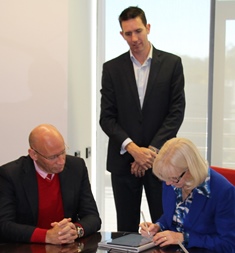A new partnership between Griffith University and Microsoft Australia will underscore a transformation of the education experience for students at Griffith.
The forward-looking collaboration, an Australian first, will combine technology and the tertiary sector in the creation of educational programs focused on making university graduates in a digital age future-ready.
Professor Debra Henly, Deputy Vice Chancellor (Academic) and Steven Worrall, Managing Director, Microsoft Australia, signed an Education Transformation Memorandum of Understanding (MoU) to formally establish the partnership.
“This is a period of enormous change in tertiary education and in recognising this Griffith University was interested in setting up a partnership that keeps us at the cutting edge in this era of digital learning,” Professor Henly said.
“The challenges in preparing students for the next 40 years are immense. What the job market will look like in the future is inconceivable. Therefore graduates need to be resilient, agile and ready to be immersed in a digital future.
“Through this unique partnership Griffith will work with Microsoft to develop technologies that progress pedagogy and create new opportunities through the education sector.”
 Steven Worrall highlighted Microsoft Australia’s focus on ongoing job creation strategies across the country and identified a need to see beyond traditional roles, traditional methods and traditional degrees when preparing young people for future employment.
Steven Worrall highlighted Microsoft Australia’s focus on ongoing job creation strategies across the country and identified a need to see beyond traditional roles, traditional methods and traditional degrees when preparing young people for future employment.
He also spotlighted the role of the tertiary education sector in equipping people who are currently in employment so they can progress their careers through periods of significant changes in their sector.
“We are excited about how our technologies can add to what Griffith does in the learning and teaching space to bring about the skilled workforce of the future,” Mr Worrall said.
“As devices and technology become more accessible, and their capabilities grow, this will unlock the potential for all students to learn, closing the skills gap and empowering graduates to achieve more in the digital age.
“Microsoft was founded on the principle that people can do remarkable things when technology is within reach.”
The Education Transformation MoU is built on three key pillars, i) Enabling academic success; ii) Enabling research collaboration; iii) Enabling institutional transformation.
